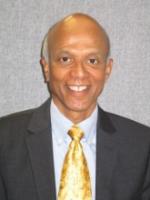
Dr. Kudva received a B.Tech in Aeronautics from the Indian Institute of Technology, Madras, India in 1973 and a PhD in Aerospace Engineering from Virginia Tech in 1979. He worked at Northrop Grumman Corporation from 1980 to 2002, where he managed a structures R&D group and spear‐headed division activities on structural health monitoring, smart materials and structures, and adaptive aircraft.
In 2003, he founded NextGen Aeronautics with the explicit purpose of developing revolutionary technologies and designs for the next century of flight. Under his leadership, NextGen has successfully executed over 200 major contracts from AFOSR, DARPA, NASA, AFRL, NAVAIR, Army as well as large aerospace system integrators including Boeing, Northrop, LM, Gulfstream and Embraer. As a prime example of NextGen’s innovation, under DARPA sponsorship, NextGen designed, developed and flight tested the world’s first two and only in‐flight morphing wing autonomous UAVs. This was done in head‐to‐head competition with major aerospace companies.
NextGen’s technology portfolio encompasses state-of-the-art sensors, aircraft design, smart systems, novel materials, wind tunnel model development, bio-mimetic vehicles, human physical performance monitoring and optimization, among others. NextGen has a proven record of successfully teaming with universities, small companies, and major defense contractors.
Dr. Kudva was honored with the SPIE Smart Structures and Materials Lifetime Achievement Award in 2007 and the AIAA ASME Adaptive Structures Prize in 2010. He was selected as an AIAA Fellow in 2015. He is currently an Adjunct Professor in the Aerospace and Mechanical Engineering Department at the University of Southern California.
While ‘smart materials,’ particularly piezoelectrics, have been known and used by the scientific community for more than a century, the term ‘smart structures’ came into vogue in the 1980s. The impetus for the research at that time was sparked by the initial demonstration of embedded fiber optic sensors in a composite laminate. Since then, hundreds of millions of dollars of R&D investment has been and continue to be made in the broad area of smart or multi-functional materials and structures. This presentation traces the historical development of this field, starting from about the mid-80s to the present, in three areas (with a primary focus on Adpative Structures):
- Health monitoring, mainly for structures, wherein sensors are attached to or embedded in the structures to monitor its (internal) health. The goal is to increase safety, reliability and possibly increase the flight envelope and reduce maintenance costs by implementing condition-based-maintenance rather than the current practice of schedule-based-maintenance;
- Integration of antennas and other sensors to provide multi-function capabilities at the component level – for instance, provide optimal structural and antenna performance, enhancing overall system capability;
- Adaptive structures wherein sensors and actuators are integrated in the structure or the overall system to change shape or state to optimize its performance for differing external conditions such as loads and flight regimes. The rationale in this case is to provide multi-point optimization at the system level, for example to realize wing shapes which could be optimal across a wide speed range, resulting in multi-mission capabilities.
While much fundamental and applied research has been conducted in all three areas, transition of the developed technologies with demonstrated performance improvements has been limited. The reasons for this are many and varied; the presentation provides a broad brush, subjective assessment of the R&D and commercialization efforts in the field and a speculative vision of the future of smart structures.
The talk will also address the joys and challenges of a starting and running a small R&D business.
Lindsay Walton
lwalton@ucsd.edu
